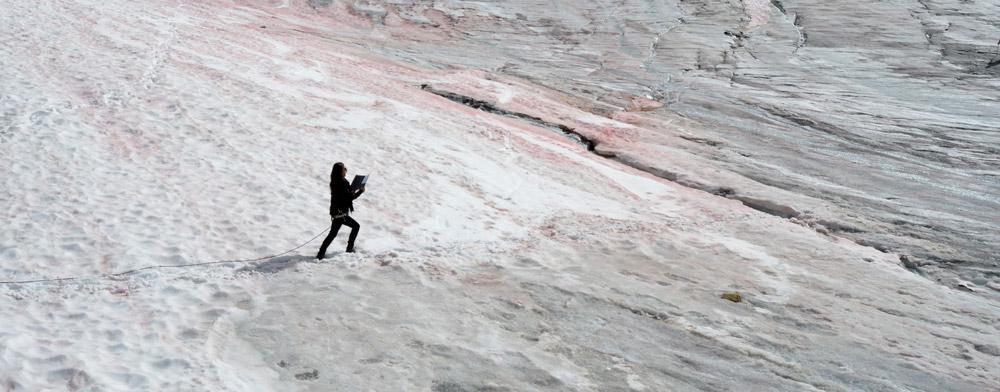Melding a four-part oratorio with a live mountainside performance and two-channel video installation, Requiem for a Glacier is Victoria artist Paul Walde’s most ambitious work to date. Its elaborate structure is a culmination of intermedia and sound-composition methods the artist has employed for 15 years and it demonstrates an essential progress: the ideas are more expansive than in Walde’s past work; the compositional systems that define his practice create a richer intertextual field; and his efficacy as a multi-disciplinary artist is impressively enhanced.
Requiem for a Glacier has several different components. The initial site-specific performance on B.C.’s Farnham Glacier was led on July 27 by Ajtony Csaba, conductor of the University of Victoria Symphony, and featured Veronika Hajdu as a soprano soloist. The installation currently at Nelson’s Oxygen Art Centre, an artist-run space, is a 40-minute, two-channel HD panoramic video projection that incorporates footage of the site-specific performance, dramatic images of the mountains, and post-production visual effects. A CD and a multimedia concert version of the project are also in the works.
“Keep Jumbo Wild” is a common bumper sticker in the southern interior of B.C., and Requiem for a Glacier plays off this as well. Local curator Kiara Lynch, formerly of Kaslo’s Langham Cultural Centre, initially contacted Walde to invite him to present his 2001 installation Northern Symphony, a multi-component work which translates the gnawed markings on a beaver-felled tree into a music score and relief-printed wallpaper, among other forms. Instead, Walde proposed creating a new work that would respond to the landscape of the Kootenays; this led to a closer look at issues facing the Jumbo Valley area and its glaciers, which are threatened by rising temperatures and a new year-round ski resort. (Ktunaxa First Nation is currently challenging the resort development in B.C.’s Supreme Court, arguing that it is situated in part of Qat’muk, a region integral to Ktunaxa spiritual culture where “the Grizzly Bear Spirit was born, goes to heal itself, and returns to the spirit world.”) Given the issues raised by the Jumbo Valley debate—including climate change, corporate privilege and indigenous rights—it is a powerful local symbol with global reach, and its glaciers easily assume the heroic status Walde casts for them in his homage.
Such is the symbolic context in which Walde composed an oratorio for orchestra and choir loosely based on the requiem mass for the dead. The work channels grief and muses solemnly, much like a number of contemporary art projects (Cape Farewell, for example) that address our devastated connection with the earth. At a talk on January 4, the artist explained how he wanted to “frame nature with culture” to highlight this trauma. In this case, Walde and Lynch took culture en large to the mountains. An entire orchestra, choir and production crew transported equipment on foot to Farnham Glacier (which is part of the ski resort development) to perform the oratorio for the environment itself. There was no human audience at the live performance, suggesting humanity banished as an anti-theme. The statement made was, sadly, self-evident: Art performs in the wilderness of our disconnected imaginations, struggling by way of an aesthetic pilgrimage to the oracular source (the mountain, the glacier) to recover purpose.
The material execution of Walde’s video installation successfully frames questions of mythic import, but halts tentatively there. The problem now becomes the limits the work encounters, the ability to see beyond the parameters of a rhetorical ceremony in which nature is observed more than engaged. Has the conceit itself of the glacier’s death created a troublesome boundary by subsuming vision to this act of observation? The requiem effectively oscillates from provocation to agitprop to a self-referencing expression of pervasive loss centred in the symbol of the glacier.
The closing shot of the video installation has the conductor clad in a black tailcoat, his back to us, conducting the glacier in blunt silence, bowing gracefully, and then walking out of the frame. The reference to Caspar David Friedrich’s Wanderer Above The Sea Of Fog (1818) is apt, and Walde’s Requiem suggests an art-historical coda to Romanticism: landscape as subject matter may no longer be responsive to our needs, as our needs are no longer responsive to landscape. Another stark and beautiful moment in the video portrays the soloist as a solitary figure climbing the glacier’s face—a sequence which lasts more than 10 minutes.
And so the work closes with a reflective finality that leaves the viewer strangely uplifted, yet stranded. Is this intentional? I think not. I think it reflects the self-imposed compositional limits adhered to, more than the anxious story addressed. For in composing, Walde sets up systems and sees where they take him. To be more specific about these compositional systems, Walde’s Requiem for a Glacier score includes methodical transpositions of data (such as climate records of rising local temperatures, and the letters j, u, m, b and o) into a standard music notation, essentially assigning notes to information. Using information to build the sonic structure of the work results in the orchestra and choir moving through unexpected shifts in pitch resulting in harmonic interweavings and dissonant tone clusters. The libretto, for its part, is based on a Latin translation of the BC government’s press release approving the Jumbo Glacier Resort proposal in March 2012.
While dramatic momentum is created in Requiem for a Glacier, it is also expected. I feel such expectation prevents a more imaginative response. The components of the work are less discrete aesthetic units—that is, things of inherent value—and more devices to be utilized, data to put into place. Such a process tends to block figurative displacements. This is an argument, I know, against conceptual strategies that say “stick to the rules.” Thankfully, Walde’s strategies do “follow rules” while also creating moments of visual beauty and intellectual wonder.









